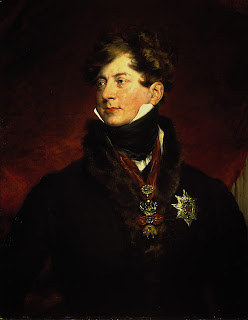 |
| George III, c.1809; studio of Sir William Beechey, NPG |
After the first regency crisis in 1788-89, George III had occasional relapses of illness and mental incapacity. However, each time he would gradually recover, and he retained the powers of his office for more than two decades.
George, Prince of Wales, bided his time, indulging in his characteristic excesses. He was not esteemed by the common people. He complained that he was not given an important post in the Army, like his brother Frederick, Duke of York, or in the Navy like his brother William, Duke of Clarence. This is how he was caricatured by James Gillray (1757-1815) in 1792 as A Voluptuary Under the Horrors of Digestion.
 |
| James Gillray, 1792 |
 |
| Caroline, Princess of Wales by Lawrence |
Acceding to his father’s and Parliament’s wishes, and to pay his debts, in 1795 he married his cousin Caroline of Brunswick, a marriage which lasted only a few days or weeks before they were effectively estranged forever. Nevertheless, a child was born nine months after the ceremonies, Princess Charlotte. At last there was a legitimate grandchild who could inherit the throne.
Marriage did nothing to improve Prince George; in fact it may have increased his reckless behavior.
 |
| Princess Amelia, Hoppner, 1785 |
The leaders of both political parties died in 1806, William Pitt, the Tory Prime Minister in January and Whig leader Charles James Fox in September, leaving a new cast of characters to assess the need for a regency.
 |
| Princess Amelia, 1783-1810, by William Beechey |
The British people had grown fond of their old king and his jubilee, celebrating 50 years on the throne, was widely acclaimed in 1809. The next year, King George III’s madness recurred. He was much distressed by the fatal illness of his youngest daughter, Princess Amelia. Though she chafed at the strictness of her parents and her virtual imprisonment at Windsor, she loved her father. Anticipating her death, she had a special jewel set for him including a lock of her hair. The very sight of it caused him tears.
The Prime Minister in 1810-11 was Spencer Perceval (1762-1812), who presided over a fractious set of ministers. Perceval, who called himself “not a Tory but a follower of Pitt”, did not like the Prince. The feeling was mutual. Perceval had taken the side of Caroline, Princess of Wales, in her disputes with her husband, and George was not a forgiving man.
But after much discussion and examination of the King by doctors and politicians alike, Perceval told the Prince that the Parliament would discuss a bill to establish a regency. George was to be ruler in the name of his father. The prince was not pleased with the restrictions placed on his actions by the bill, which was very similar to the one passed by Commons and almost passed by the House of Lords in 1789. These restrictions had mainly to do with the creations of peerages and other offices, awards and pensions. The Queen would be responsible for the care of the King.
For some of the members of both Commons and Lords, the bill gave too much power to the Prince. But despite the bill’s shortcomings, it passed in early February, 1811, and the Regency was established. The Prince took the Royal Oath on February 6.
To the surprise of almost everyone, the Prince Regent did not choose new ministers from his close friends, the Whigs. The Parliament had many issues on its agenda, such as continuation of the Peninsular War, the problems of Ireland, and banking concerns.
Meanwhile, the Prince Regent continued his spendthrift ways. He prided himself on his connoisseurship; he built, remodeled, bought, collected and wasted incredible amounts of public money. However, for the remainder of the regency and his ten years as George IV, his tastes and his extravagances gave Britain a lasting legacy in the royal collections and palaces. Whether it had anything to do with his influence or not, there was a flowering of literary talent on his watch. Byron, Keats, Shelley, Austen, Scott – an endless list. And the painters Constable, Turner, Lawrence and many others were at the top of their games. Architecture, the decorative arts, and garden design developed brilliantly.


How interesting that an age of such excess on the part of the Regent may well have aided the flourishing literary and artistic offerings of the period. As a classically trained musician I can see it. The joke was that the foremost interests in the minds of musicians are music, sex and food, but not necessarily in that order! I would assume that might hold true for other artists as well!